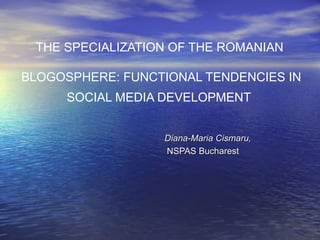
Blogosphere in Romania: functional tendencies
- 1. THE SPECIALIZATION OF THE ROMANIAN BLOGOSPHERE: FUNCTIONAL TENDENCIES IN SOCIAL MEDIA DEVELOPMENT Diana-Maria Cismaru, NSPAS Bucharest
- 2. Methodology Objective of the research: the detection of changes in the Romanian blogosphere in two years Design of research: panel; method: the content analysis Phases of research: a. January 1-3, 2008. Sample: 270 blogs on wordpress.com (selection by Google) b. January 1-3, 2010. Sample: 300 blogs on wordpress.com (same selection). The criteria for framing: the identity of the author, the type of selection and of treatment of information, individual/collective author, the lifetime of the blog. The unit of analysis: the theme; the unit of numbering: the sentence.
- 3. Types of blogs 1. Personal blogs: present the author, his/her personality and his interests: a. narrative blogs: b. “life philosophy”; c. “personal comment”: d. “comment of public life”: e. “take over” (a personal “press review”). 2. Professional blogs: the author uses the professional identity. There are presented only issues from a particular field. 3. Blogs type “hobby”: the author does not use the personal identity or the professional one, but a partial identity, which values a side passion or other domain of interest). 4. Collective “niche” blogs: blogs built round an idea (for instance, the romanian culture, environment policies, religion). 5. Corporate blogs: a blog with several usernames placed under the identity of an organization. 6. “Online reviews”: magazines organized and presented as a blog. 7. Temporary blogs: built only for the preparation and the presentation of some events (blogs maintained only until the event takes place).
- 4. Comparison: 2008 and 2010 data Categories Subcategories 2008 2010 1. 41,3% 45% 1a 7% 2,6% 1b 4% 5,3% 1c 20,7% 21,3% 1d 6,6% 11% 1e 3% 4,6% 2. 4,4% 13,6% 7. 3% 3%
- 5. Comparison: 2008 and 2010 data Categories Subcategories 2008 2010 3. 8,5% 27,3% 3a. 4% 3b. 7,6% 3c. 7,3% 3d. 2% 3e. 6,3% 4 13,5% 6% 5 1,4% 3% 6 4% 2%
- 6. Interpretation 1. Personal blogs increased. (1a) decreased (4a) doubled and (5a) changed in “useful blogs”. 2. Professional blogs are third times more in 2010 than in 2008 (positive aspect ). 3. Individual “niche blogs” changed from “hobby” blogs in media products with a clear target and identity: (3a) art blogs, (3b) entertainment blogs, (3c) idea blogs (3d) humanitarian blogs (fundraising) (3e) religious. 4. The collective “niche” blogs have now a clearer identity. 5. Corporate blogs had a modest development in two years. 6. Online reviews changed but not as a kind but as placement. 7. Temporary blogs remained at the same percentage, but diversified.
- 7. “First 100 blogs” Categories General sample Top 100 1. 45% 42% 2. 13,6% 20% 3. 27,3% 18% 4. 6% 10% 5. 3% 0% 6. 2% 9% 7. 3% 0%
- 8. Success factors (a)The frequency of entries: in most cases there are daily posts or more. (b) The seniority: the blogs that came first won adherents and audience, by the entrance in a free space. (c) The notoriety in offline: if the author is a public figure, the online identity is like a new completion of the real identity. (d) The clear and consistent profile: blog’s authors rely either on the diversity of the information (more areas) either on specialization (only one area, in a creative way). (e) The organization and the presentation of information: personal sites which deliver complex and attractive information are successful. (f) The community built round the blog. The process of building a community: the trust and the familiarity with the issues and the perspective of the author have a leading role).
- 9. Conclusions (a) Specialization and individualization of the blogs’ profiles: authors became more responsible and more skilled. (b) The status of bloggers become one of “professionals”. The promotion of “new media products” and the relationship with the community changed, becoming more structured and following positioning objectives. (c) The audiences became selective and use blogs as an information and interpretation source, and not as an entertainment source.
